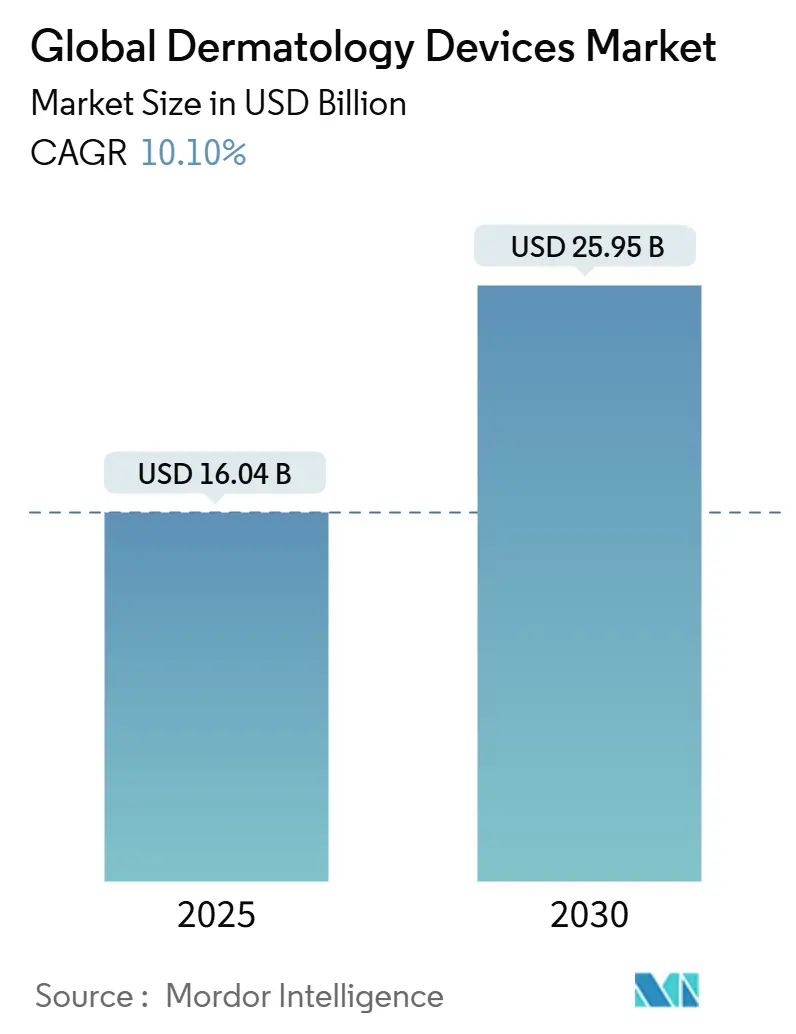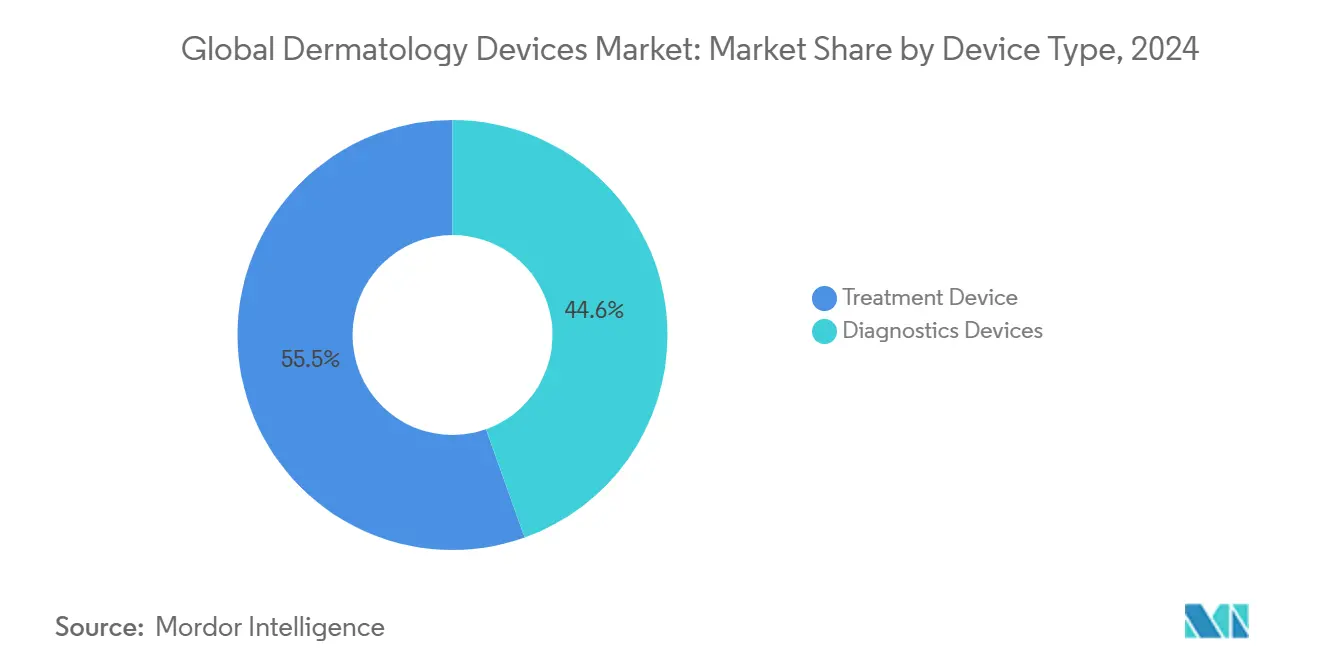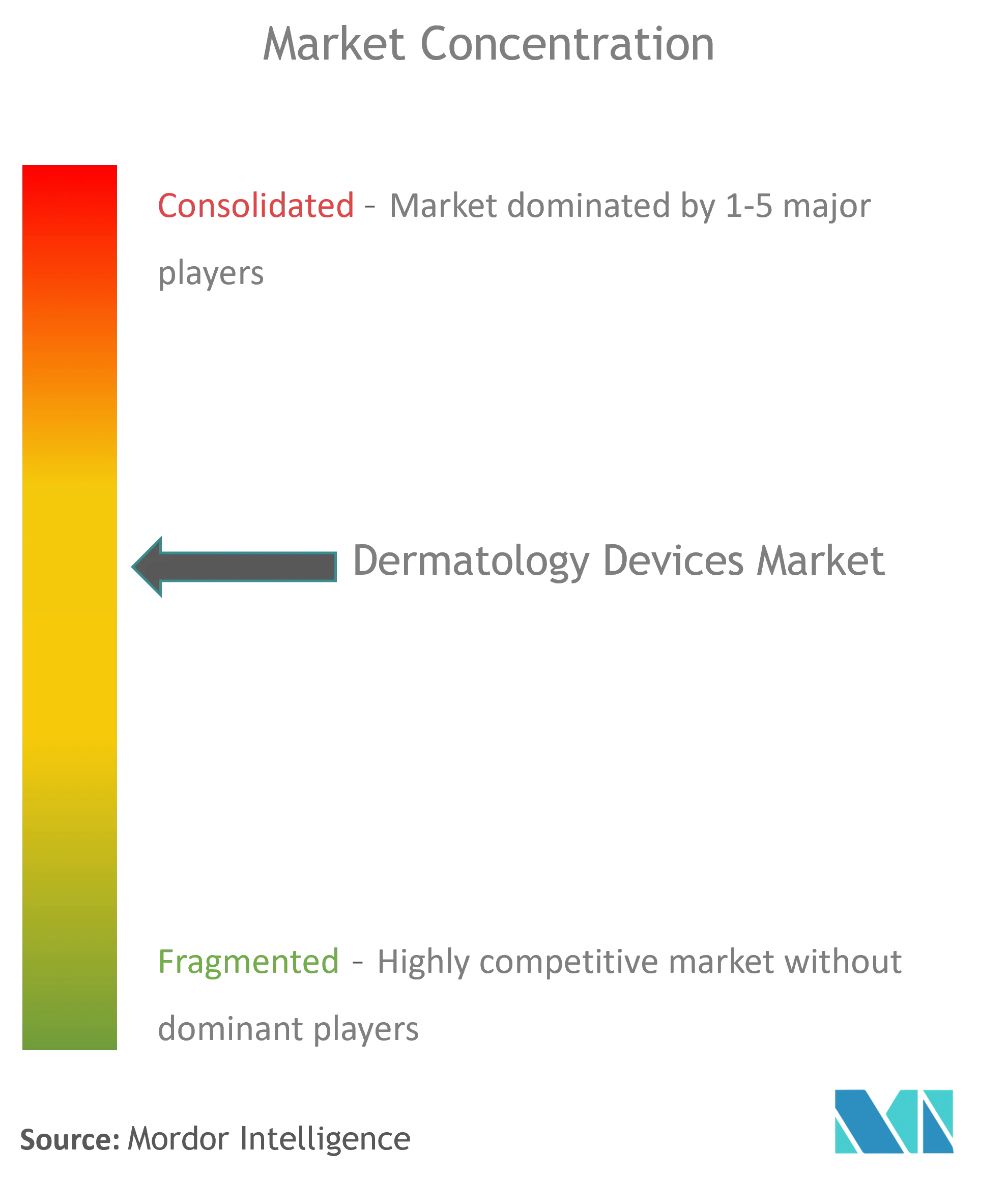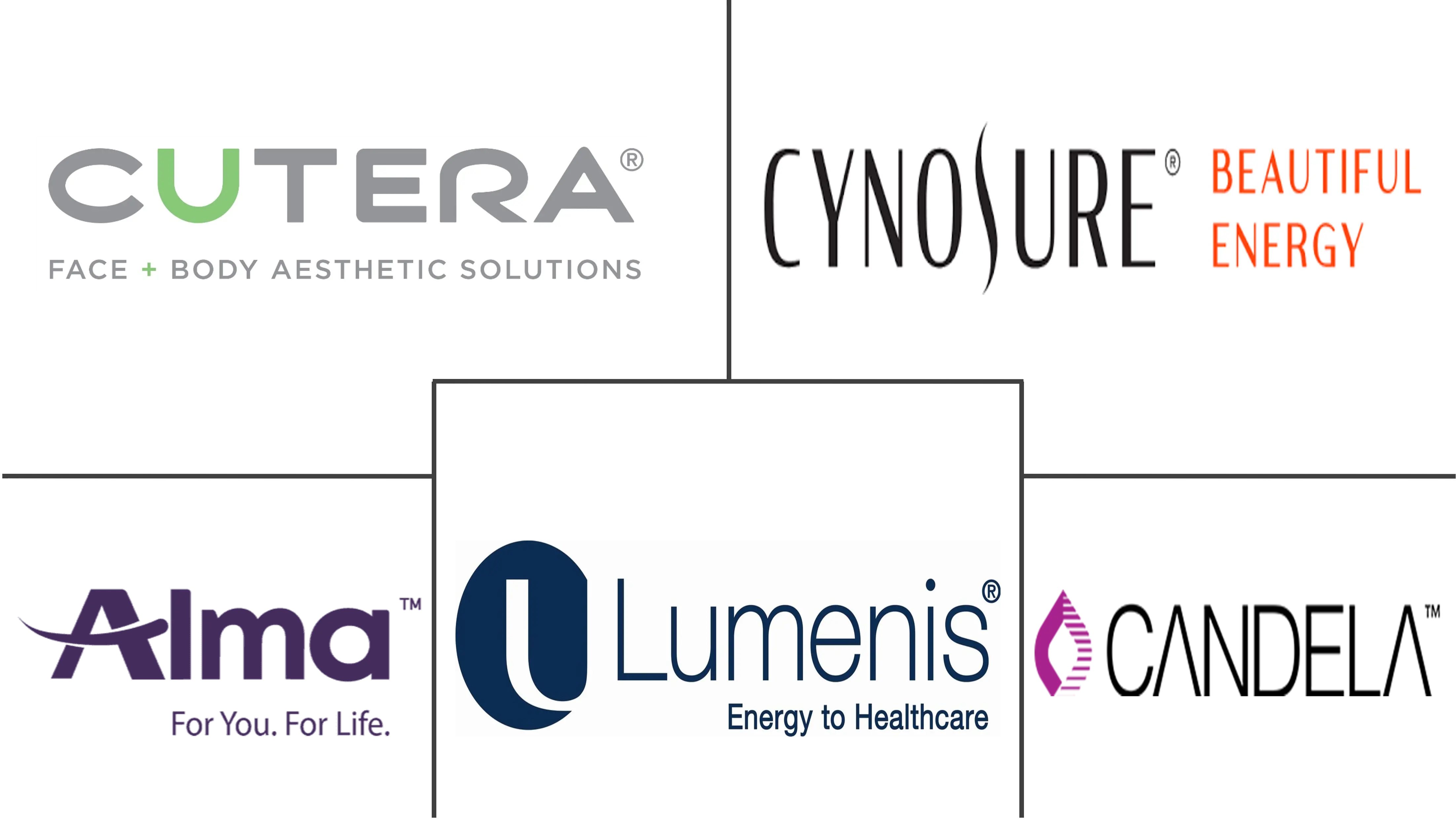Global Dermatology Devices Market Size and Share

Global Dermatology Devices Market Analysis by Mordor Intelligence
The dermatology devices market was valued at USD 16.04 billion in 2025 and is on track to reach USD 25.95 billion by 2030, advancing at a 10.1% CAGR. The growth trajectory reflects a clear migration from reactive care to predictive diagnostics enabled by artificial intelligence, lasers with real-time thermal monitoring, and tele-dermatology connectivity. Demand remains anchored in established treatments for hair removal and lesion ablation, yet AI-guided imaging now pushes earlier detection of skin cancers into primary-care settings, shortening referral times and expanding patient pools. At the same time, consumer appetite for minimally invasive aesthetics keeps procedure volumes high in clinics, medical spas, and ambulatory surgery centers. Regional patterns diverge: North America benefits from reimbursement clarity, but Asia-Pacific captures the fastest expansion on the back of rising disposable income, government support for domestic manufacturing, and widening specialist networks. Tightened EU regulations and Medicare fee cuts temper momentum, yet they also favor firms with robust quality systems and diversified revenue models.
Key Report Takeaways
By device type, treatment systems held 55.45% of the dermatology devices market share in 2024, while diagnostic platforms are projected to log the highest 10.85% CAGR through 2030.
By application, hair removal commanded 30.05% of the dermatology devices market size in 2024; skin rejuvenation is forecast to expand at 11.21% CAGR to 2030.
By end user, dermatology clinics led with 44.50% revenue share in 2024, whereas ambulatory surgical centers are advancing at an 11.59% CAGR through 2030.
By geography, North America accounted for 41.56% of revenue in 2024; Asia-Pacific is set to post the quickest 11.98% CAGR during the forecast horizon.
Global Dermatology Devices Market Trends and Insights
Driver Impact Analysis
| Driver | (~) % Impact on CAGR Forecast | Geographic Relevance | Impact Timeline |
|---|---|---|---|
| Rising prevalence of skin cancer & other disorders | 2.8% | Global, with concentration in North America & Australia | Long term (≥ 4 years) |
| Growing demand for minimally-invasive cosmetic procedures | 2.1% | North America & Europe core, expanding to APAC | Medium term (2-4 years) |
| Technological advances in lasers & light-based systems | 1.9% | Global, led by North America & Europe | Medium term (2-4 years) |
| AI-enabled diagnostic imaging & tele-dermatology adoption | 1.7% | North America & Europe, selective APAC markets | Short term (≤ 2 years) |
| Broader insurance coverage in emerging economies | 0.9% | APAC core, Latin America & MEA selective markets | Long term (≥ 4 years) |
| Source: Mordor Intelligence | |||
Rising Prevalence of Skin Cancer & Other Disorders
Skin cancer already affects up to one quarter of the United States population, and incidence is accelerating in regions with historically limited specialist coverage IntechOpen. Earlier detection drives dual demand: handheld spectroscopy units guide primary-care triage, while non-surgical treatment devices—such as superficial radiation and photodynamic therapy lamps—allow clinicians to manage lesions that once required excision[1]Source: Centers for Medicare & Medicaid Services, “Local Coverage Determination LCD 40167,” cms.gov
. Academic evidence that fractional CO₂ lasers reduce actinic damage supports preventive protocols, reinforcing device necessity in routine practice PubMed.
Growing Demand for Minimally Invasive Cosmetic Procedures
Global procedure volumes continue to shift toward injectables, resurfacing, and body contouring. Medical spas and chain clinics bypass hospital procurement cycles, accelerating unit turnover and rewarding suppliers with flexible leasing or pay-per-use models. Longer-acting neurotoxins and biostimulatory fillers further intertwine cosmetic and therapeutic indications, effectively enlarging the dermatology devices market.
Technological Advances in Lasers & Light-Based Systems
Next-generation lasers add wavelengths tailored to oil-gland thermolysis, vascular chromophore absorption, and precise collagen remodeling. The FDA clearance of a 1726 nm platform that achieved 70% inflammatory acne reduction after four sessions set a clinical benchmark for non-drug acne control HCPLive. Consensus protocols for fractional CO₂ therapy now encompass diverse Fitzpatrick skin types, easing operator variability and broadening patient eligibility. Thermal cameras integrated into handpieces help avoid overtreatment, expanding physician confidence and patient safety margins.
AI-Enabled Diagnostic Imaging & Tele-Dermatology Adoption
In January 2024 the FDA cleared an AI-powered handheld spectrometer that detects melanoma, basal-cell, and squamous-cell cancers with 95.5% sensitivity, halving miss rates among family physicians. Cloud connectivity allows remote double-reading, giving rural clinics near-instant specialist support. Breakthrough status for ultra-high-resolution confocal imaging systems underscores regulator enthusiasm for diagnostic democratization Medical Device Network. Revenue streams now include subscription analytics and teleconsultation, tilting business models toward recurring income.
Restraint Impact Analysis
| Restraint | (~) % Impact on CAGR Forecast | Geographic Relevance | Impact Timeline |
|---|---|---|---|
| High acquisition & procedure costs | -1.4% | Global, acute in emerging markets | Long term (≥ 4 years) |
| Stringent regulatory approval pathways | -1.1% | Europe & North America, expanding globally | Medium term (2-4 years) |
| Scarcity of trained dermatology specialists in LMICs | -0.8% | APAC emerging, Latin America & Sub-Saharan Africa | Long term (≥ 4 years) |
| Source: Mordor Intelligence | |||
High Acquisition & Procedure Costs
Medicare cut the 2025 physician conversion factor to USD 32.35, nudging clinics to defer large-ticket equipment purchases. Manufacturers of energy-based devices, including several publicly traded firms, reported revenue contraction and have initiated restructuring to trim debt and overhead. In lower-income countries, limited capital budgets push providers toward refurbished systems or rental models, slowing premium platform penetration.
Stringent Regulatory Approval Pathways
The EU Medical Device Regulation has lengthened certification cycles and forced half of European manufacturers to shrink portfolios in order to focus on high-volume devices. Similar complexities in China oblige foreign firms to establish local testing and adverse-event reporting, adding cost and risk Med Device Online. Small innovators often partner or exit rather than finance multiple regulatory tracks.
Segment Analysis
By Device Type: Treatment Dominance Masks Diagnostic Revolution
Treatment systems represented 55.45% of revenue in 2024, anchored by hair-removal lasers, vascular lesion systems, and radiofrequency body-contouring. Within that base, recurring consumables and service contracts keep growth steady at a projected 10.85% through 2030. Yet diagnostic platforms are now the fastest improvers, led by AI-integrated spectroscopy and high-definition dermoscopy. A dual-wavelength fractional system launched in 2025 merges imaging feedback with resurfacing output, illustrating how hybrid designs erode the once-rigid boundary between diagnosis and therapy. Entry-level cryotherapy units still serve primary-care and veterinary niches, whereas photodynamic lamps gain oncology codes that secure reimbursement for actinic keratosis.

By Application: Aesthetic Procedures Drive Innovation Beyond Medical Necessity
Hair removal maintained 30.05% of 2024 revenue, confirming its maturity and price competition. Skin rejuvenation, however, will compound at 11.21% over the forecast window as millennials pursue pre-juvenation regimens and insurers recognize scar-revision benefits. Acne and psoriasis management also accelerates thanks to 1726 nm and 577 nm lasers that spare surrounding tissue. Meanwhile, AI-supported dermatoscopes broaden skin-cancer screening outside specialist offices, contributing to the dermatology devices market via software subscriptions. The robust evidence base comparing CO₂ and Er:YAG for acne-scar resurfacing continues to shape standardized treatment algorithms across skin tones.
By End User: Ambulatory Centers Challenge Traditional Hospital Dominance
Dermatology clinics held 44.50% of 2024 sales but face share dilution as ambulatory surgery centers post an 11.59% CAGR on the strength of bundled payments, efficient turnover, and patient convenience. Device makers respond with compact footprints, intuitive interfaces, and disposable tips that cut sterilization downtime. Hospitals retain complex oncologic workups, yet physician shortages projected to reach 86,000 by 2036 motivate broader point-of-care deployment of AI diagnostics in primary-care offices[2]Source: AAMC, “Physician Supply & Demand Projections 2023-2036,” aamc.org
. Tele-dermatology providers and mobile units supply capacity in rural districts, further diversifying the user base.

Note: Segment shares of all individual segments available upon report purchase
Geography Analysis
North America commanded 41.56% of 2024 revenue. The market benefits from clear FDA pathways, high per-capita procedure rates, and private-insurance coverage of elective treatments. Breakthrough designations for AI diagnostics and acne lasers demonstrate regulatory willingness to speed true innovation. Still, reimbursement cuts and staffing gaps may temper growth, leading clinics to favor platforms with diversified indications and robust service support.
Europe ranks second but faces MDR-linked certification bottlenecks that advantage companies with scale and formal clinical-data repositories. Demand remains strong for pigment and vascular systems, especially in Germany, France, and the United Kingdom, where aesthetic procedure counts continue to climb despite economic headwinds. Because providers are pruning device inventories to limit compliance burden, vendors offering consolidated multi-application workstations gain traction.
Asia-Pacific is the growth engine, forecast at an 11.98% CAGR through 2030. China targets an 8% device CAGR to USD 55.67 billion by 2029, bolstered by policies that localize production and expedite national-reimbursement code approvals. Korea and Japan lead technology adoption in pigmentation and atopic-dermatitis laser therapy, while India shows quick uptake of affordable AI dermatoscopes in tele-health programs. Urban medical tourism in Thailand and Malaysia adds demand for resurfacing and tattoo removal.
Latin America and the Middle East deliver mid-single-digit gains centered on private clinics in Mexico, Brazil, Saudi Arabia, and the UAE. Currency swings and import duties affect capital-equipment cycles, driving interest in leasing. Africa lags, constrained by funding and limited specialist density; mobile tele-dermatology hubs using AI triage hold promise for incremental access expansion.

Competitive Landscape
The dermatology devices market is moderately consolidated, with about 45% of revenue accruing to the five leading manufacturers. Traditional leaders focus on incremental power, pulse-duration, and ergonomic refinements, while smaller entrants exploit AI and platform connectivity to outpace legacy diagnostics. In April 2024 a private-equity-backed merger joined two laser specialists, forming a portfolio that spans pigmentation, vascular, and body-contouring franchises—proof that scale and cross-selling matter when reimbursement headwinds strike. Patent disputes continue: the U.S. International Trade Commission opened a Section 337 investigation in 2025 covering certain handpiece assemblies. Meanwhile, subscription analytics and cloud-based image libraries create annuity revenue for AI start-ups that partner with large OEMs rather than compete outright. Across all tiers, vendors differentiate through on-site training, clinical-study sponsorship, and pay-per-click marketing support for high-volume aesthetic practices.
Global Dermatology Devices Industry Leaders
-
Cutera Inc.
-
Hologic Inc. (Cynosure Inc.)
-
Lumenis Ltd
-
Alma Lasers
-
Candela Corporation
- *Disclaimer: Major Players sorted in no particular order

Recent Industry Developments
- April 2025: Bausch Health’s Solta Medical launched Fraxel FTX™, a dual-wavelength fractional laser with ergonomic upgrades unveiled at ASLMS 2025
- March 2025: Cutera entered a pre-packaged Chapter 11 plan to shed nearly USD 400 million in debt and secure USD 65 million in new financing
Research Methodology Framework and Report Scope
Market Definitions and Key Coverage
Our study defines the dermatology devices market as all diagnostic and treatment equipment that physicians use inside hospitals, dermatology clinics, ambulatory surgical centers, and medical spas to visualize, ablate, reshape, or remove skin, hair, and subcutaneous tissue. Typical platforms include dermatoscopes, high-resolution imaging systems, lasers, light therapy units, electrosurgical consoles, liposuction handpieces, cryotherapy probes, and microdermabrasion wheels.
Scope exclusion: home-use beauty gadgets and topical skin-care applicators that do not require professional supervision are outside the estimate.
Segmentation Overview
- By Device Type
- Diagnostic Devices
- Dermatoscopes
- Confocal Microscopes
- Imaging Systems (Optical, Ultrasound)
- Treatment Devices
- Lasers (CO₂, Er:YAG, Excimer, Dye)
- Light / Phototherapy Systems
- Electrosurgical Units
- Cryotherapy Devices
- Micro-dermabrasion Devices
- Liposuction & Body-Contouring Systems
- Diagnostic Devices
- By Application
- Skin Cancer Diagnosis
- Hair Removal
- Skin Rejuvenation & Resurfacing
- Acne, Psoriasis & Vitiligo Treatment
- Pigmented & Tattoo Lesion Removal
- Vascular Lesions
- Body Contouring / Fat Reduction
- By End-user
- Hospitals
- Dermatology Clinics
- Ambulatory Surgical Centers
- Other End-users
- By Region
- North America
- United States
- Canada
- Mexico
- Europe
- Germany
- United Kingdom
- France
- Italy
- Spain
- Rest of Europe
- Asia-Pacific
- China
- India
- Japan
- South Korea
- Australia
- Rest of Asia-Pacific
- South America
- Brazil
- Argentina
- Rest of South America
- Middle East and Africa
- GCC
- South Africa
- Rest of Middle East and Africa
- North America
Detailed Research Methodology and Data Validation
Primary Research
Mordor analysts interviewed practicing dermatologists, biomedical engineers, procurement managers, and aesthetic chain owners across North America, Europe, China, and the GCC. The discussions explored annual patient throughput, consumable pull-through rates, and replacement cycles, letting us check and refine assumptions from secondary work.
Desk Research
We began by mapping supply flows and procedure volumes through open sources such as the US FDA 510(k) database, Eurostat trade codes, American Academy of Dermatology factsheets, WHO cancer registries, and PubMed journals. Company 10-Ks and investor decks clarified revenue splits, while statistics from South Korea's HIRA and Japan's MHLW illustrated regional adoption curves. Select paid datasets, notably D&B Hoovers for manufacturer financials and Questel for patent velocity, filled remaining gaps. These references are illustrative; many other materials supported data collection and validation.
A second pass gathered price lists, import duties, and reimbursement tariffs that influence average selling prices and installed-base growth. News archives on Dow Jones Factiva tracked quarterly device launches and recalls, giving early signals for scenario building.
Market-Sizing & Forecasting
The model starts with a top-down reconstruction of global procedure pools derived from cancer incidence, aesthetic treatment prevalence, and tattoo removal demand. These volumes are paired with region-specific device penetration ratios, capacity utilization, and weighted average prices, then checked through sampled supplier roll-ups and channel feedback. Multivariate regression links unit growth to disposable income, dermatologist density, aging population share, and regulatory approval count, while an ARIMA overlay captures short-term swings. When supplier data are incomplete, peer-country analogs adjusted for purchasing power close the gaps.
Data Validation & Update Cycle
Outputs undergo variance checks against external benchmarks, followed by peer review before sign-off. We refresh every twelve months, with interim updates triggered by material recalls, landmark approvals, or geopolitical shocks.
Why Mordor's Dermatology Devices Baseline Stands Up to Scrutiny
Published figures often differ because firms choose dissimilar product baskets, currency bases, and refresh cadences.
Key gap drivers are varied. Some studies exclude imaging systems or emerging med-spa channels. Others apply uniform pricing across regions or assume linear growth despite regulatory lag. A few release numbers only every three years, whereas we revisit totals each year.
Benchmark comparison
| Market Size | Anonymized source | Primary gap driver |
|---|---|---|
| USD 16.04 B (2025) | Mordor Intelligence | |
| USD 16.81 B (2024) | Global Consultancy A | Omits ambulatory surgical centers, single price corridor |
| USD 19.46 B (2025) | Industry Association B | Includes consumer-grade gadgets, limited primary validation |
| USD 6.20 B (2022) | Regional Consultancy C | Narrow device definition, outdated currency conversion |
This comparison shows that our disciplined scope selection, annual refresh, and dual-source validation give decision-makers a balanced benchmark traceable to clear variables and repeatable steps.
Key Questions Answered in the Report
Why is Asia-Pacific the fastest-growing dermatology devices market?
Robust healthcare investment, supportive government policies, and rising middle-class demand push Asia-Pacific toward an 11.98% CAGR through 2030, outpacing all other regions.
Which segment is expanding quicker—diagnostic or treatment devices?
Although treatment systems still deliver 55.45% of 2024 revenue, diagnostic platforms anchored by AI imaging are registering the highest 10.85% segment CAGR.
How do Medicare fee cuts affect device adoption?
The 2.83% reduction in 2025 reimbursement lowers disposable income for clinics, encouraging rentals or deferred purchases and pressuring manufacturers to offer flexible financing.
What drives the surge in ambulatory surgical centers?
Patient preference for same-day procedures and bundled pricing enables ambulatory centers to grow at 11.59% CAGR, eroding share from hospital outpatient departments.
Which application is poised for the fastest growth?
Skin rejuvenation, buoyed by pre-juvenation trends and improved fractional lasers, is projected to grow at 11.21% CAGR through 2030.
Page last updated on:



